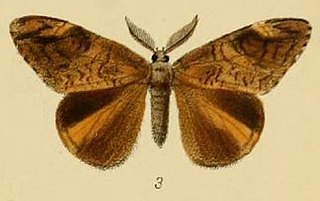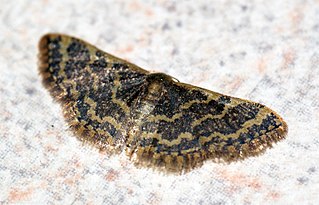Siccia is a genus of moths in the family Erebidae. The genus was erected by Francis Walker in 1854.
Dunira is a genus of moths of the family Erebidae. The genus was erected by Frederic Moore in 1885.

Aroa is a genus of moths in the subfamily Lymantriinae first described by Francis Walker in 1855. Species are distributed in South Africa, China, throughout India, Sri Lanka, Myanmar, and Java.

Plutodes is a genus of moths in the family Geometridae erected by Achille Guenée in 1857.
Siccia guttulosana is a moth of the family Erebidae first described by Francis Walker in 1863. It is found in India and Sri Lanka.
Siccia minima is a moth of the family Erebidae first described by George Hampson in 1900. It is found in Sri Lanka.
Siccia sordida is a moth of the family Erebidae first described by Arthur Gardiner Butler in 1877. It is found in India, China, Thailand, Japan, and Sri Lanka.
Siccia tau is a moth of the family Erebidae first described by Franciscus J. M. Heylaerts in 1891. It is found in India, Java, and Sri Lanka.
Chusaris idaeoides is a moth of the family Noctuidae described by George Hampson in 1891. It is found in Sri Lanka.
Goniocraspedon mistura is a moth of the family Noctuidae first described by Charles Swinhoe in 1891. It is found in India, Sri Lanka and Australia.
Nagadeba polia is a moth of the family Noctuidae first described by George Hampson in 1891. It is found in Sri Lanka.
Aroa sienna is a moth of the family Erebidae first described by George Hampson in 1891. It is found in India (Nilgiri) and Sri Lanka.

Conolophia nigripuncta is a moth of the family Geometridae first described by George Hampson in 1891. It is found in Sri Lanka, the Indian subregion, Myanmar, Indochina and Borneo.

Idaea purpurea is a moth of the family Geometridae first described by George Hampson in 1891. It is found in India, Sri Lanka, Taiwan, the Andaman Islands, Peninsular Malaysia and Borneo.
Metorthocheilus emarginata, or Chundana emarginata, is a moth of the family Uraniidae first described by George Hampson in 1891. It is found in the Indian subregion, Sri Lanka, Taiwan, Borneo, Java and Seram.
Mixomelia relata is a moth of the family Noctuidae first described by George Hampson in 1891. It is found in India and Sri Lanka.

Rivula basalis is a moth of the family Erebidae first described by George Hampson in 1891. It is found in South India, Sri Lanka, Indo-China, Thailand, South China, Taiwan, Java, Bali and Borneo.
Hypena assimilis, is a moth of the family Erebidae first described by George Hampson in 1891. It is found in India, Sri Lanka and Taiwan.
Hypena griseapex, is a moth of the family Erebidae first described by George Hampson in 1891. It is found in India and Sri Lanka.
Earias luteolaria is a moth of the family Nolidae first described by George Hampson in 1891. It is found in India, Sri Lanka, Borneo, Hong Kong and Australia.




